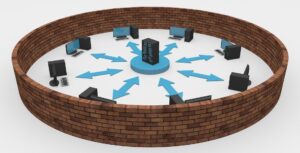
Resilience as a Goal: Rebuilding the LA Region
Los Angeles is on track to execute the fastest disaster cleanup in history following the devastating wildfires of January 2025. As crews sweep through communities leveled by flames, home and business owners are now looking toward the rebuilding process. They face a myriad of decisions about their next steps: do they sell and move on? Duplicate what was lost? Reimagine their property in a whole new configuration?
For those who elect to stay and rebuild, the choices available are almost limitless for the new construction of a house or commercial site. What should be prioritized, however, is not the design or building specs. Both companies and individuals must escalate their risk management practices to limit or prevent the chance of similar losses in the future. What people need to consider now is their future capacity for resilience in the face of catastrophe.
LA’s Cleanup Efforts
The impact of the billions of dollars invested by the State of California into aid and assistance for the affected neighborhoods is notable. With help from federal agencies, the debris from more than 1,300 properties was removed within the first 80 days. (In contrast, it took over four months to clear 920 properties destroyed by the 2019 Hill and Woolsey fires.)
Support resources for displaced populations have also made a positive contribution to the recovery effort:
• The federal Small Business Administration is overseeing more than $1.8 billion in low-interest loans offered to both homeowners and businesses as they begin their repair or replacement projects. And FEMA (the Federal Emergency Management Agency) has provided almost 32,000 people with over $102 million in financial resources to help them through this calamity.
• California has focused on providing interim support for displaced families, including $24.2 million for urgent housing and shelter needs, $21 million for short-term housing, and more than $73 million for ‘Other Needs’ assistance – financial support to cover medical and dental services, property losses, and other costs related to the disaster.
• Data provided by California government agencies reveals that state-based recovery centers have had more than 60,000 visits related to the fires.
By these accounts, it appears likely that the region will be able to achieve ‘near normal’ activities much sooner than initially expected.
However, what that ‘new normal’ will look like is still very much an unknown. The COVID-19 pandemic and past similar natural disasters all offer lessons on how to recover from these immense devastations. New approaches to living and working can now be incorporated into the rebuilding process to address the weaknesses revealed by the fires. The recovery processes following each individual event – a fire, a flood, or other such calamity – provide insight and instruction for those facing these decisions today. Rising to the top of the ‘consideration’ list: how to enhance risk management to facilitate future resilience.
Risk Management Now = Recovery Resilience Later
Perhaps the biggest lesson derived from previous disasters is that they exposed unexpected hazards and vulnerabilities for which there was no contingency planning. Property and financial losses grew exponentially as established ‘disaster recovery’ processes failed to address the actual damages that were occurring. During the pandemic, for example, restaurants that held comprehensive fire and physical loss insurances had no such coverage to protect them when the coronavirus compelled them to close their doors for an extended period (or, in some cases, forever). While that circumstance was unique even from a disaster perspective, it does illustrate that traditional ‘disaster recovery’ efforts are rarely comprehensive of all potential threats.
Applying that lesson to today’s realities indicates that anyone interested in rebuilding their ‘estate’ – personal, corporate, or both – should expand the scope of their ‘recovery parameter’ to incorporate ‘resilience measures ‘ to guard against losses driven by future crises. To do that, they’ll need to revise their present practices and policies to embrace the four elements of resiliency:
• Agility,
• Responsiveness,
• Flexibility, and
• Predictability.
To achieve these attributes, both individuals and businesses can look to emerging tools and operating models that will help develop, embed, and maintain a more resilient enterprise.
Embrace Technology
Not surprisingly, today’s technology – most notably Artificial Intelligence (AI) – provides significant resources to expose currently unseen threats and develop appropriate, crisis-mitigating solutions to the challenges they pose. AI-enabled predictive analytics programming can now ferret through billions of data bits to assess for hidden risks or systemic gaps. The consequent remediation of these threats both reduces the likelihood of actual failure while also improving current and future decision-making procedures.
Rethink the Workforce
For most occupations, workers are hired to perform a single function or set of functions. They are not typically included in the decision-making process, nor are their perspectives considered in the analysis of enterprise success. This mindset is changing. The pandemic, in particular, was instrumental in removing foregone assumptions of employee values as management and staff worked together to address the unique challenges posed by COVID; the emergence of the janitorial staff as ‘essential workers‘ is just one example. Leaders who want their organizations to excel in the future should be open to the creativity and insights provided by their current workforce to capture more value from that resource than was previously acknowledged.
Acknowledge Sustainability as a Business Imperative
Even with California’s strict and precise urban fire prevention codes in place, the LA region was still vulnerable to extensive fire damage, as was demonstrated by January’s events. In some cases, the failure of home- and business owners to adequately protect their property against fire threats actively contributed to their destruction – and that of their neighbors. Data indicates that these lapses in judgment can affect more than the company’s physical plant. Consumers are actively seeking to do business with entities that take longer-term environmental concerns into consideration in their day-to-day operations. These days, they are choosing to engage with enterprises that demonstrate mastery of both social responsibility and sustainability capacities. Further, companies with the most to gain from embracing this eco-friendly strategy will also engage their entire corporate ecosystem, including their partners and supply chains, to ensure that they retain their customers’ loyalty.
Clearing away the debris and detritus of January’s firestorms is the first step in LA’s rebuilding effort. Incorporating enhanced risk management strategies to reduce or eliminate the likelihood of similar catastrophes in the future should be the first element of that rebuilding effort. Entities that successfully adopt resiliency as a fundamental business tenet stand a good chance of thriving through the current community recovery period and surviving whatever threats are posed by the next disaster.


